The Hunger strike and General strike of 1920
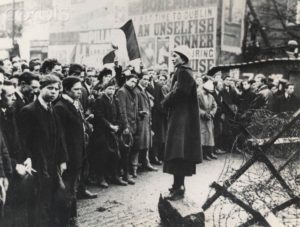
By John Dorney
In early April 1920, a young IRA man, Christopher ‘Todd’ Andrews was arrested by British troops at his family home in Terenure, Dublin.
The first he knew of his arrest was when his mother appeared at his bedroom door with a candle, followed by a polite but businesslike young British lieutenant, who told him to dress and take a few belongings.
Had it been a year later, Andrews wrote, and his captors Black and Tans, he could well have been summarily shot, as were two of his friends, a year later who ‘were told to run for it and were riddled with bullets as they did so’.
As it was though, he had dumped his revolver earlier at a safe house and ‘was neither surprised nor dismayed by news of my arrest’. The young Andrews saw it as rite of passage that every Irish rebel went through. The British troops, he remarked were friendly, one even told him ‘keep your heart up Paddy’ as he was driven by lorry first to the Portobello Barracks and then to Mountjoy Gaol. [1]
Little did Andrews know that he would go on to spend ten days on hunger strike and then be released to jubilant crowds outside Mountjoy Gaol, in one of the most dramatic events of the Irish revolution.
Internment
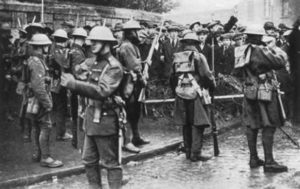
Andrews was arrested as part of a general ‘round up’ by the British Army from January 1920 onwards. The Lord Lieutenant Sir John French, after his own near death at the hands of the IRA in December 1919, had pressured the Chief Secretary for Ireland, Ian McPherson into a policy of wholesale arrest, internment and in some cases deportation to England of ‘dangerous persons’, by the military.[2]
In Dublin alone there were over 1000 raids and 86 arrests in January, including 6 members of the Dail; the republican parliament declared in 1919. Hundreds more arrests followed in February, March and early April. Many arrested were low level activists and not all of them were republicans, trade union officials also being targeted. Those captured, however, included many important IRA figures, including Peadar Clancy, deputy commander of the Dublin Brigade.[3]
Hundreds of republican and labour activists were arrested and interned under the Defence of the Realm Act in early 1920.
In Cork there were also hundreds of arrests of IRA officers, which Liam Deasy, IRA commander, called, a ‘serious blow’.[4]
A curfew was also instituted in Dublin from midnight to 5am and anyone violating was arrested. Republican propagandist Erskine Childers wrote, ‘as the citizens go to bed, the barracks spring to life, lorries, tanks and armoured cars with searchlights muster in fleets. A thunder of knocks, no time to dress (even for women alone) or the door will crash in. On opening, in charge the soldiers with fixed bayonets and full war kit.’[5]
The British Army report on the campaign in Dublin remarked that in early 1920, ‘things were looking black for Sinn Fein, many leaders were in our hands and the activity of the Crown forces was on the increase’.[6]
The Army’s view was perhaps overly optimistic from their own point of view. The IRA had been attacking police barracks across the country since January. In early April they had systematically burned over 100 abandoned barracks all over Ireland as well as tax offices.
But the British policy of wholesale internment was overturned, in April 1920, not by force of arms but by an extraordinary combination of hunger strike, popular mobilisation and ultimately a work stoppage by the Irish trade unions that, for two days, brought the country to a standstill.
It was the most signal example of mass struggle, as opposed to small group guerrilla warfare, in the Irish War of Independence; exposing at once the shaky will of the British authorities and the fallacy that the struggle was merely one of an isolated ‘murder gang’ against the ‘forces of order’.
Hunger strike
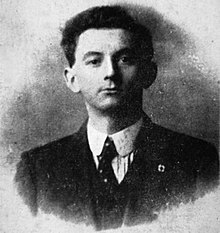
Hunger strike was a weapon that Irish republicans happened upon, in imitation of the feminist Suffrage activists, who had employed the tactic prior to the First World War. It was a tactic of ‘moral force’, refusing food in protest against what activists considered illegitimate arrest.
In 1917, Irish Volunteer leader Thomas Ashe had died on hunger strike after force feeding in Mountjoy Gaol in Dublin, an event that had done much to galvanise public sympathy for the republican movement.
Now in 1920, it was a labour activist, William O’Brien, who first employed the hunger strike as a protest against his arrest without trial.
O’Brien, an official of the Irish Transport and General Workers’ Union, was arrested on March 3 and was deported to Wormwood Scrubs prison in England. He went on hunger strike on March 18. The Irish Labour Party had his case raised in Parliament by the British Labour Party and on March 26, O’Brien was released.[7]
Irish Republicans had copied the tactic of hunger strike from women’s suffrage activists. Now they used it to demand the status of political prisoners.
Perhaps inspired by O’Brien’s example, the republican prisoners in Mountjoy Gaol in Dublin, led by Peadar Clancy, followed suit. On April 5 36 of them refused food, followed by 30 more the day after. By April 9, 90 men were on strike.[8]
Their demands were for political status, but more concretely: better food, separation from ordinary criminal prisoners, no compulsory prison work, books, a weekly bath, the right to smoke and five hours exercise per day.[9]
The 18 year old Todd Andrews, who had been imprisoned for only two days, before the strike started, was very impressed by Clancy’s leadership, amounting almost to hero worship. Clancy ‘left on me the indelible impression of a superman, a man whose commands I at least would have had a compulsion to obey’.
On account of his youth, Andrews was told that he did not have to join the fast but he told the older men that he ‘thought it was my duty to strike with the others’. He, like the others, turned down the next meal delivered to their cells, a ‘miserable meal’ of a mug of soup, some potatoes and meat.[10]
The strike was on.
Mass protests
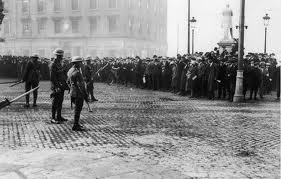
Within days, huge crowds had assembled outside Mountjoy Gaol, demonstrating for the release of the hunger strikers before they died. Very prominent were women activists, many of whom knelt in the front row of the crowds and said the Catholic rosary outside the prison.
The military remarked that, ‘large and menacing crowds, in some cases up to 20,000 strong, congregated outside Mountjoy’.[11] Photographs taken at the time show troops in steel helmets and fixed bayonets, as well as tanks, behind coils of barbed wire facing the crowds. At one point Royal Air Force planes flew at rooftop height over the protestors in an attempt to intimidate them.
Huge crowds gathered outside Mountjoy Gaol to demand the release of the prisoners.
By April 13, the military were beginning to consider the possibility the possibility of spraying the crowd with machine gun fire from the air in order to disperse them.[12]
Sinn Fein did their best to prevent a massacre, councillor John O’Mahoney telling the crowd to back off and that ‘the prayers of the people is the only effective weapon’. Later, IRA members stewarded the crowd to try to prevent an open confrontation with the troops.[13]
Todd Andrews, in Mountjoy, who had been taken into the prison hospital as a precaution, was elated to hear from the warders of the mass protests outside, but bemused by a newspaper report that he ‘a boy of 18…had collapsed and was in a state of delirium’. He was worried however on seeing photographs of his distressed father outside, who was pictured speaking to republican activist Maude Gonne and Laurence O’Neill, the mayor of Dublin. [14]
The perception on the outside, though not the reality, was that the prisoners were on the verge of death after six days of fasting.
General Strike
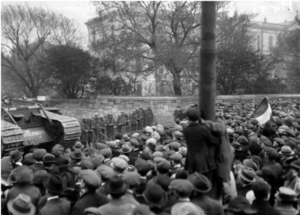
The hunger strike and the demonstrations it sparked in Dublin were all worrisome for the British administration in Ireland and for the government in London. They were well aware of the radicalising effect the death of Thomas Ashe had had in 1917 and had no wish to see fresh republican martyrs in the prisons.
John French, however, the Lord Lieutenant, who had been since mid 1918 a kind of military governor in Ireland, was against any concessions, preferring to let the prisoners die than to reverse, as he saw it, the progress the military had made since they had commenced mass arrests in January.
What brought the situation to a head was the action of the Irish Trade Union Council, who called a general strike for April 13, ‘in protest at the inhuman treatment of political prisoners and to demand their immediate release’.[15] The trade unionists had seen many of their own members arrested and acted on their own initiative, apparently without consulting with Sinn Fein or the IRA.
A general strike demanding the release of all prisoners was called starting on April 13. It forced the British authorities to backtrack.
The mobilisation they commanded was impressive. Outside the unionist dominated north, Ireland came to a standstill for two days. While there was some intimidation of reluctant workers and business owners – in Naas, County Kildare, for instance, ‘Red Guards’ forced the shops to shut – the strike could not have succeeded as it did without mass support.
Trains and other public transport stopped running, pickets forced most shops to close and mass rallies were held in Dublin, Cork, Limerick, Sligo and elsewhere. In Kenmare, in Kerry trade unionists first ensured that the town’s businesses were shut and then paraded to the church where they said the rosary for the release of the prisoners.[16]
Most extraordinary of all were the efforts of the strike committees in towns all over the country, often styling themselves ‘Soviets’ after the workers’ councils in revolutionary Russia. They endeavoured to police the strike, setting food prices, distributing food and patrolling the streets to ‘keep order’. In Bagenalstown County Carlow, they even declared, ‘a Provisional Soviet Government’ at Kilmallock, County Limerick, ‘red flaggers stopped traffic’ and referred to themselves as a ‘Soviet regime’.[17]
Such tactics are probably realistically seen more as a staple of popular labour militancy at the time than as attempts at workers’ revolution. Strike committees for instance issued orders not to interfere with British troops – ‘the forces of occupation’ – and the ‘Soviets’ were voluntarily disbanded as soon as the strike was over.
But what they did do was demonstrate the power of organised labour, and after only two days of the general strike, the British were ready to backtrack and talk to the hunger strikers.
Release
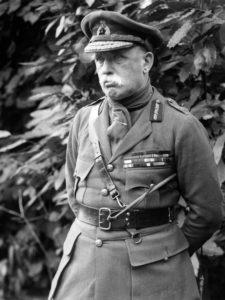
As a consequence of the strike, the British opened talks with the hunger strikers’ leader Peadar Clancy and offered him concessions, including political status and release on parole, both of which offers he refused. He remarked to his comrades, ‘the general strike has them beat’ and held out for release.[18]
There followed a remarkable foul up on the British side. First it was decided to release those prisoners who had not yet been charged with a crime, after a medical inspection.
Someone blundered and in error, all prisoners, including non-political ones were released after the medical examination. As British legal advisor, WE Wylie, remarked, ‘jailbirds, political prisoners, petty thieves, every damn one of them [were freed]. I nearly fainted when I heard it’.[19]
In an attempt to save some face, French the Lord Lieutenant proceeded to formally release all the prisoners around the country to make it appear as if it was a preconceived policy of pardon. This amounted to hundreds of IRA prisoners, 100 in Cork alone for instance, as well as the ninety hunger strikers released in Dublin. Small wonder that a subsequent inquiry into the workings of Dublin Castle by a civil servant Warren Fisher, characterised the administration as ‘chaos’.
In a remarkable series of blunders, the British mistakenly released all prisoners held. Sir John French then tried indicate that this had been his intention.
French was frozen out of the British administration in Ireland shortly afterwards, though he remained nominally as Lord Lieutenant, and Ian McPherson was replaced as Chief Secretary by Hamar Greenwood, on the recommendation of the new British military commander in Ireland, Nevil Macready.[20]
The released hunger strikers found themselves to be popular heroes. Todd Andrews was taken out of Mountjoy in an ambulance, through a cheering crowd, ‘hysterical with joy’ to the Mater hospital, which he confessed, he scarcely needed. Within a few days he was back with his IRA company of Fourth Battalion, Dublin Brigade, planning to burn the local police barracks.[21]
On April 21 the Irish republican prisoners who had been deported to Wormwood Scrubs prison in England also went on hunger strike and shortly afterwards, they too were released, mostly returning to Ireland.
For the British military, the whole affair was a disastrous humiliation; ‘the military and police secret service personnel were virtually driven off the streets, owing to those whom they had arrested now being set free and in many cases able to identify them… military and police activities abated …[the IRA’s] morale and truculence began to increase accordingly’.[22]
The British capitulation to the hunger strikers was a cardinal error on their part, making them appear at once tyrannical and also weak-willed and easily beatable.
For the guerrillas of the IRA it was indeed a great morale boost. And for the labour movement it showed the great power they could wield by a general strike. But over the next year and a half, as the political conflict in Ireland became increasingly bloody, it was increasingly the gun rather than the moral force of the strike and the mass protest that would predominate.
Peadar Clancy, who had held the April 1920 hunger strike was summarily executed by the Auxiliaries in Dublin Castle after his arrest on ‘Bloody Sunday’ in November of that year.
References
[1] CS Andrews, Dublin Made Me (2008) p.144-145
[2] Richard Holmes, The Little Field Marshal, a Life of Sir John French, p.354. Arrest were made under section 14B of the Defence of the Realm Act (DORA).
[3] Padraig Yeates, Dublin a City in Turmoil 1919-1921, p.105
[4] Peter Hart, The IRA and its Enemies, p.56
[5] Quoted in C Desmond Greaves, The Irish Transport and General Workers Union, the Formative Years, p.263
[6] William Sheehan, ed. Fighting for Dublin, The British battle for Dublin 1919-1921, p.11
[7] Greaves, p.264
[8] It may be significant that one of the prisoners who joined the republican hunger strike in Mountjoy was also an official from the Transport Union, Conor Kostick, Revolution in Ireland p.128
[9] Charles Townsend, the Republic, The Struggle for Irish Independence, p.143
[10] Andrews, Dublin Made Me, p.148-149
[11] Sheehan, Fighting for Dublin p.12
[12] Ibid. p.13
[13] Kostick, Revolution in Ireland p.136
[14] Andrews, p.151
[15] Greaves, p.265
[16] Ibid.
[17] Greaves, p.265-266, See also, Kostick, Revolution in Ireland p.132-134
[18] Yeates, City in Turmoil, p113
[19] Michael Hopkinson, The Irish War of Independence, p.36
[20] Ibid.
[21] Andrews p.152-155
[22] Sheehan, Fighting for Dublin, p.15